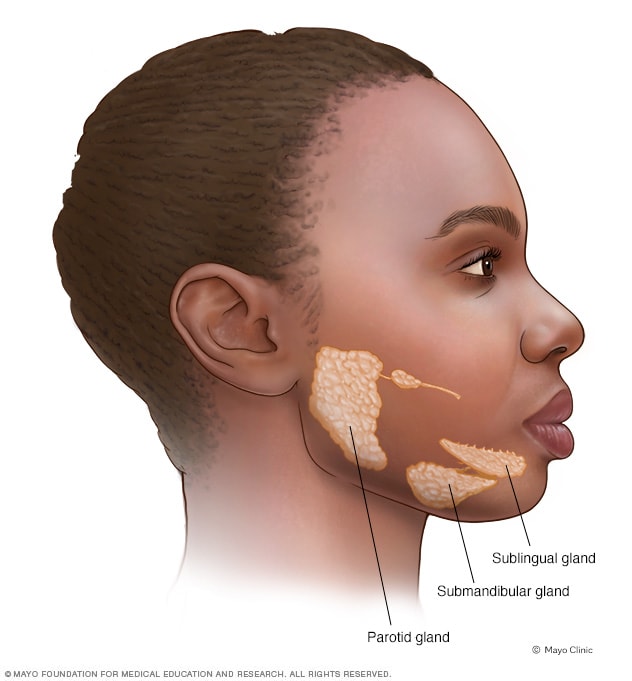Overview
Salivary glands

Salivary glands
There are three pairs of major salivary glands. These glands are the parotid, sublingual and submandibular glands. Each gland has its own tube, called a duct, leading from the gland to the mouth.
Salivary gland tumors are growths of cells that start in the salivary glands. Salivary gland tumors are rare.
The salivary glands make saliva. Saliva aids in digestion, keeps the mouth moist and supports healthy teeth. There are three pairs of major salivary glands under and behind the jaw. These are the parotid, sublingual and submandibular glands. Many other tiny salivary glands are in the lips, inside the cheeks, and throughout the mouth and throat.
Salivary gland tumors can happen in any salivary gland. Most salivary gland tumors occur in the parotid gland. Of these, most aren't cancer. For every five parotid gland tumors, on average, only one is found to be cancerous.
Treatment for salivary gland tumors is usually with surgery to remove the tumor. People with salivary gland cancers may need additional treatments.
Products & Services
Types
Symptoms
Signs and symptoms of a salivary gland tumor may include:
- A lump or swelling on or near the jaw or in the neck or mouth.
- Muscle weakness on one side of the face.
- Numbness in part of the face.
- Ongoing pain near a salivary gland.
- Trouble opening the mouth widely.
- Trouble swallowing.
When to see a doctor
Make an appointment with your doctor or other healthcare professional if you have any symptoms that worry you.
Causes
The cause of many salivary gland tumors isn't known. Healthcare professionals have identified some things that raise the risk of salivary gland tumors. These include smoking and radiation therapy for cancer. Not everyone with a salivary gland tumor has these risk factors, though. More research is needed to find out exactly what causes these tumors.
Salivary gland tumors happen when cells in a salivary gland develop changes in their DNA. A cell's DNA holds the instructions that tell the cell what to do. In healthy cells, the DNA gives instructions to grow and multiply at a set rate. The instructions also tell the cells to die at a set time. In tumor cells, the changes give different instructions. The changes tell the tumor cells to make many more cells quickly. Tumor cells can keep living when healthy cells would die. This causes too many cells.
Sometimes the changes in the DNA turn the cells into cancer cells. Cancer cells can invade and destroy healthy body tissue. In time, cancer cells can break away and spread to other parts of the body. When cancer spreads, it's called metastatic cancer.
Types of salivary gland tumors
Many different types of salivary gland tumors exist. Salivary gland tumors are classified based on the type of cells involved in the tumors. Knowing the type of salivary gland tumor you have helps your healthcare team decide which treatment options are best for you.
Types of salivary gland tumors that aren't cancerous include:
- Pleomorphic adenoma.
- Basal cell adenoma.
- Canalicular adenoma.
- Oncocytoma.
- Warthin tumor.
Types of cancerous salivary gland tumors include:
- Acinic cell carcinoma.
- Adenocarcinoma.
- Adenoid cystic carcinoma.
- Clear cell carcinoma.
- Malignant mixed tumor.
- Mucoepidermoid carcinoma.
- Oncocytic carcinoma.
- Polymorphous low-grade adenocarcinoma.
- Salivary duct carcinoma.
- Squamous cell carcinoma.
Risk factors
Factors that may increase the risk of salivary gland tumors include:
- Older age. Though salivary gland tumors can happen at any age, they most often happen in older adults.
- Radiation exposure. Radiation treatments for cancer, such as radiation used to treat head and neck cancers, may increase the risk of salivary gland tumors.
- Smoking tobacco. Smoking tobacco is shown to increase the risk of salivary gland tumors.
- Viral infections. People who have had viral infections such as Epstein-Barr virus, human immunodeficiency virus and human papillomavirus may have a higher risk of salivary gland tumors.
- Workplace exposure to certain substances. People who work with certain substances may have an increased risk of salivary gland tumors. Examples of industries associated with an increased risk include those that involve rubber manufacturing and nickel.